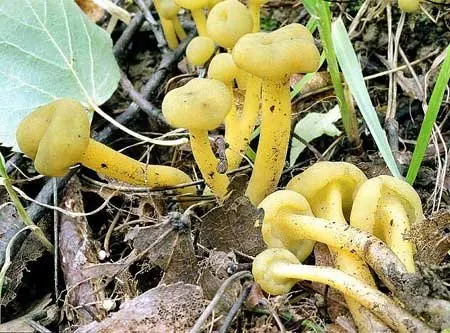Leotia gelatinous (Leotia lubrica)
- Department: Ascomycota (Ascomycetes)
- Subdivision: Pezizomycotina (Pezizomycotins)
- Class: Leotiomycetes (Leociomycetes)
- Subclass: Leotiomycetidae (Leocyomycetes)
- Order: Helotiales (Helotiae)
- Family: Leotiaceae
- Genus: Leotia
- Type: Leotia lubrica (Leotia gelatinous)

Hat: represents the top of the leg – false. Slightly rounded, often sinuously curly, bumpy. In the central part it is slightly indented with a neat edge tucked inward. In the process of mushroom growth, the cap does not change and does not become prostrate. The hat is 1-2,5 cm in diameter. The color is dirty yellowish to bright orange. According to literary sources, the cap of gelatinous leotia, when infected with parasitic fungi, becomes bright green. However, this applies to any type of mushroom from the genus Leotia. The cap has a mucous surface.
Pulp: gelatinous, yellowish-green, dense, gelatinous. It has no pronounced odor. The hymenophore is located over the entire surface of the cap.
Spore powder: fungus spores are colorless, spore powder, according to some sources – white.
Leg: leg 2-5 cm high, up to 0,5 cm thick. Relatively even, hollow, cylindrical shape. Often slightly flattened, the same color as the cap, or may remain yellow when the cap turns olive. The surface of the leg is covered with light small scales.
Spread: The fungus Leotia lubrica is very common according to some sources, and quite rare according to others. We can say that it is not common, but everywhere. The mushroom comes across at the end of summer and in September in forests of various types. Practice shows that the main places of distribution are flooded spruce and pine forests, literary sources point to deciduous forests. As a rule, gelatinous leotia bears fruit in large groups.
Similarity: In some places, but not in our country, you can meet other representatives of the genus Leotia. But the characteristic color of the cap of gelatinous leotia makes it possible to distinguish it from other mushrooms. It is conditionally possible to refer to similar species and representatives of the genus Cudonia, but this genus is distinguished by a dry, gelatinous pulp. However, it is not worth writing about similar species regarding gelatinous leotia, since due to the specific appearance and manner of growth, the fungus is determined instantly.
Edibility: do not eat the mushroom.









